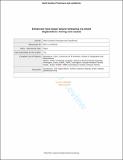Files in this item
Enhanced rock-slope failure following ice-sheet deglaciation : timing and causes
Item metadata
| dc.contributor.author | Ballantyne, Colin | |
| dc.contributor.author | Wilson, Peter | |
| dc.contributor.author | Gheorghiu, Delia | |
| dc.contributor.author | Rodés, Àngel | |
| dc.date.accessioned | 2014-11-28T00:01:29Z | |
| dc.date.available | 2014-11-28T00:01:29Z | |
| dc.date.issued | 2014-06-14 | |
| dc.identifier | 59150990 | |
| dc.identifier | 17dcf600-9fb3-4bcb-be8c-456895d8106d | |
| dc.identifier | 84901913621 | |
| dc.identifier | 000337604700005 | |
| dc.identifier.citation | Ballantyne , C , Wilson , P , Gheorghiu , D & Rodés , À 2014 , ' Enhanced rock-slope failure following ice-sheet deglaciation : timing and causes ' , Earth Surface Processes and Landforms , vol. 39 , no. 7 , pp. 900–913 . https://doi.org/10.1002/esp.3495 | en |
| dc.identifier.issn | 0197-9337 | |
| dc.identifier.uri | https://hdl.handle.net/10023/5839 | |
| dc.description | This research was supported by NERC Cosmogenic Isotope Analysis Facility [Grant Number: 9046.0308] | en |
| dc.description.abstract | The temporal pattern of rock-slope failures (RSFs) following Late Pleistocene deglaciation on tectonically stable terrains is controversial: previous studies variously suggest (1) a rapid response due to removal of supporting ice (‘debuttressing’), (2) a progressive decline in RSF frequency, and (3) a millennial-scale delay before peak RSF activity. We test these competing models through beryllium-10 (10Be) exposure dating of five closely-spaced quartzite RSFs on the Isle of Jura, Scotland, to establish the relationship between timing of failure and those of deglaciation, episodes of rapid warming and periods of rapid glacio-isostatic uplift. All five dated RSFs occurred at least 720–2240 years after deglaciation, with the probability of failure peaking ~2 ka after deglaciation, consistent with millennial-scale delay model (3). This excludes debuttressing as an immediate cause of failure, though it is likely that time-dependent stress release due to deglacial unloading resulted in progressive development of failure planes within the rock. Thaw of permafrost ice in joints is unlikely to have been a prime trigger of failure as some RSFs occurred several centuries after the onset of interstadial warming. Conversely, the timespan of the RSFs coincides with the period of maximum glacio-isostatic crustal uplift, suggesting that failure was triggered by uplift-driven seismic events acting on fractured rock masses. Implications of this and related research are: (1) that retreat of the last Pleistocene ice sheets across tectonically-stable mountainous terrains was succeeded by a period of enhanced rock-slope failure due to deglacial unloading and probably uplift-driven seismicity; (2) that the great majority of RSFs in the British Isles outside the limits of Loch Lomond Stadial (= Younger Dryas) glaciation are of Lateglacial (pre-Holocene) age; and (3) numerous RSFs must also have occurred inside Loch Lomond Stadial (LLS) glacial limits, but that runout debris was removed by LLS glaciers. | |
| dc.format.extent | 14 | |
| dc.format.extent | 2243935 | |
| dc.language.iso | eng | |
| dc.relation.ispartof | Earth Surface Processes and Landforms | en |
| dc.subject | rock-slope failure | en |
| dc.subject | paraglacial | en |
| dc.subject | surface exposure dating | en |
| dc.subject | stress release | en |
| dc.subject | palaeoseismicity | en |
| dc.subject | GB Physical geography | en |
| dc.subject.lcc | GB | en |
| dc.title | Enhanced rock-slope failure following ice-sheet deglaciation : timing and causes | en |
| dc.type | Journal article | en |
| dc.contributor.institution | University of St Andrews. Geography & Sustainable Development | en |
| dc.identifier.doi | 10.1002/esp.3495 | |
| dc.description.status | Peer reviewed | en |
| dc.date.embargoedUntil | 2014-11-28 |
This item appears in the following Collection(s)
Items in the St Andrews Research Repository are protected by copyright, with all rights reserved, unless otherwise indicated.

